Flying power of the Navy: what is the naval aviation of Russia armed with
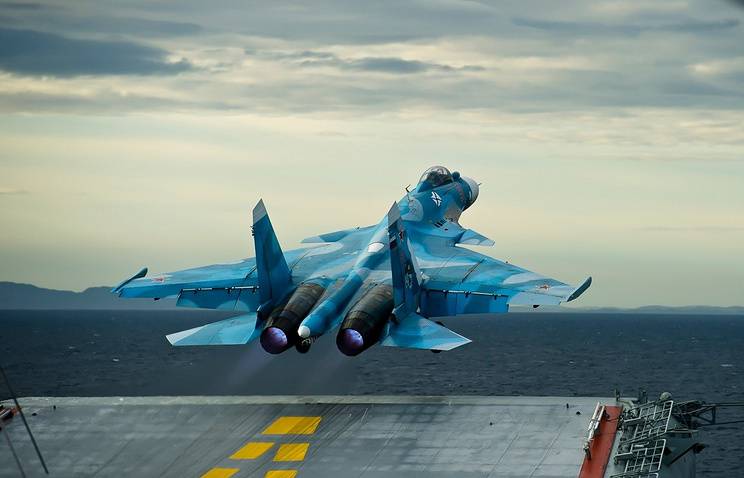
100 years since the first victory of Russian naval pilots during the First World War. July 17 (July 4, old style), 1916, four M-9 seaplanes from the Orlitsa Baltic carrier fleet defended against the German air raid the Russian naval base on the island of Saaremaa (now - the territory of Estonia). Two Kaiser planes were shot down, Russian hydroplanes returned without loss.
Marine aviation - the type of forces of the Russian Navy, designed to search and destroy the enemy, cover groups of ships and objects from air strikes, as well as to conduct air reconnaissance.
Naval aviation is functionally subdivided into several genera: naval missile-carrying, anti-submarine, fighter, reconnaissance and auxiliary. Depending on the location, it is conditionally divided into carrier-based and coast-based aircraft.
The Russian Navy currently has one aircraft carrier, the Admiral of the Fleet of the Soviet Union Kuznetsov, a heavy aircraft carrier. Based on it:
deck fighters Su-33, MiG-29K / KUB;
Su-25UTG training aircraft;
Ka-27, Ka-29 and Ka-31 multipurpose ship-borne helicopters.
It is expected that in the near future attack helicopters Ka-52K Katran will be based on the cruiser. Projects of a promising aircraft carrier and universal amphibious assault ships are under development.
In service with coastal aviation of the Russian Navy:
long-range anti-submarine aircraft Tu-142 (modification of the strategic bomber Tu-95);
Anti-submarine aircraft IL-20 and IL-38;
MiG-31 interceptor fighters;
An-12, An-24, An-26 transport aircraft;
Ka-52K, Mi-8, Mi-24, Ka-31 helicopters and others.
fighter aircraft
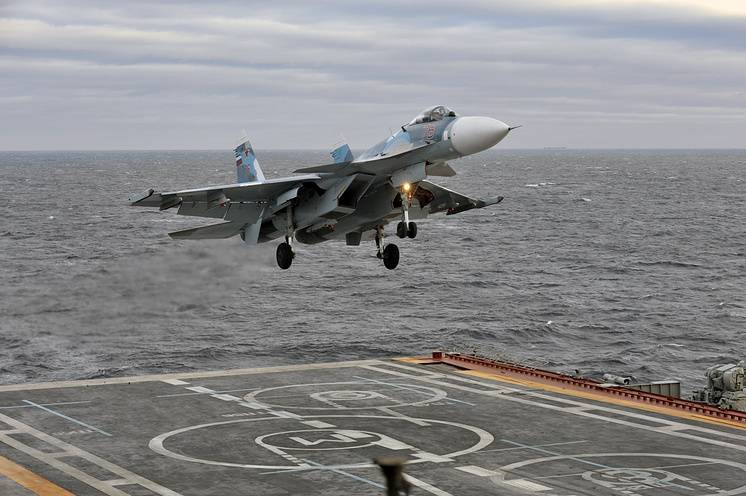
Su-33
The fourth-generation Russian carrier-based fighter, developed for the Russian Navy at the Sukhoi Design Bureau under the leadership of Mikhail Petrovich Simonov, formerly known as Su-27K (according to the NATO codification: Flanker-D).
The first flight of the Su-27K took place on August 17 1987, and on November 1 1989, the Su-27K was the first in the USSR to take off and land on the aircraft carrying cruiser Admiral Kuznetsov.
Adopted on 31 August 1998, and since then has been the main carrier-based aircraft of the Russian Navy.
The aircraft is controlled by a single pilot, is armed with a built-in 30-mm cannon GSH-30-1, air-to-air guided missiles, unguided missiles, as well as bombs.
The maximum speed of the fighter is 2300 km / h, the practical ceiling is 17 000 meters, the flight range is 3000 km.
Of the 26 4 aircraft serial machines are lost in accidents.
Su-33 part of the cruiser "Admiral Kuznetsov."
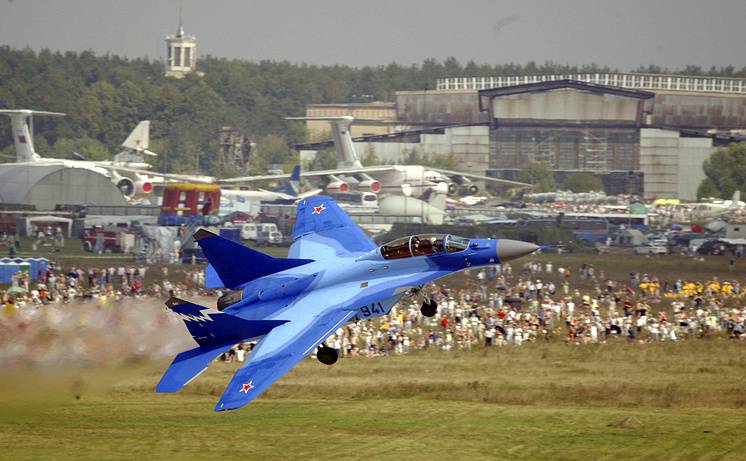
MiG-29K
MiG-29K / KUB
The fourth-generation Russian deck multipurpose fighter, a further development of the MiG-29 (according to NATO codification: Fulcrum-D).
Deck-based fighters are multifunctional weatherproof machines of the 4 ++ generation. Their task is to air defense and anti-ship defense of the connection of ships, striking attacks on ground targets of the enemy.
MiG-29K can be based on aircraft-carrying ships capable of receiving airplanes weighing more than 20 tons, equipped with a take-off springboard and landing arresting equipment, as well as at ground aerodromes.
The aircraft are armed with guided missiles RVV-AE and P-73E for air combat, anti-ship missiles X-31А and X-35, anti-radar missiles X-31П and adjustable bombs KAB-500Кр to destroy ground and surface targets.
The maximum flight speed is 2300 km / h, the practical ceiling is 17500 m, the flight range is 2000 km.
It is planned that in the future the basis of the carrier-based fighter aircraft of Russia will be MiG-29K / KUB airplanes.
MiG-29K / KUB fighters were introduced to the ship's deck aviation regiment, serving on the Admiral Kuznetsov cruiser, not instead of its existing Su-33 and Su-25UTG, and in addition to them will be used in conjunction with them.
Attack and combat training aircraft
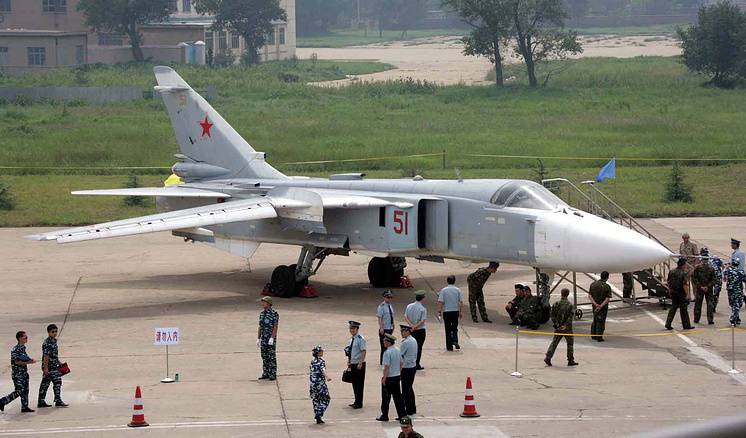
Su-24
All-weather front-line bomber. It is intended for launching air strikes against ground and surface targets, including at low altitudes.
The first prototype flight (T-6) made 2 July 1967 year. Adopted by the USSR Air Force 4 February 1975 of the year.
It was serially built in 1971-1993 in Komsomolsk-on-Amur and Novosibirsk. Total released about 1400 aircraft.
The maximum speed is 1400 km / h, the practical range is 2850 km, the practical ceiling is 11 thousand meters. Crew - 2 person.
Armament - 23 mm caliber cannon, on 8 suspension points the aircraft can carry air-to-surface and air-to-air missiles, uncontrolled and corrected aerial bombs and projectiles, and removable cannons. On board can carry tactical nuclear bombs.
The order of 120 modified units is planned to be replaced by Su-34 by 2020 year.
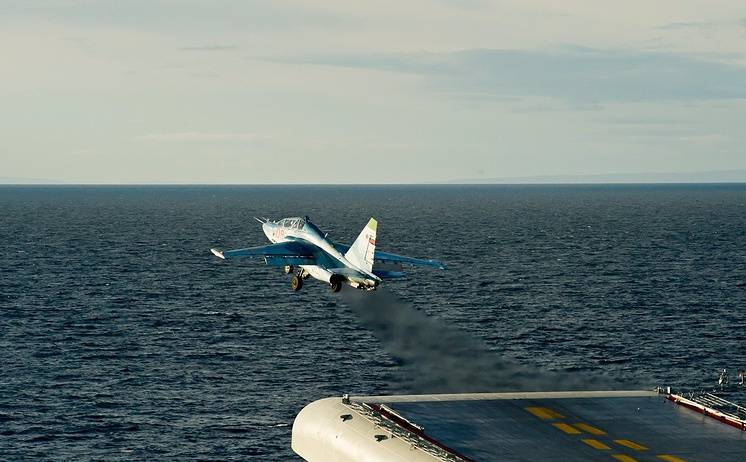
Su-25UTG fighter
Sioux 25UTG
Training aircraft on the basis of combat training attack aircraft Su-25UB. Differs from it in the absence of sighting equipment, control system units weapons, a cannon installation with a cannon, girder holders and pylons, armored screens for engines, radio communication stations with ground forces, blocks and elements of the defense system.
The first flying sample was created based on the Su-25UB (Т8-УТГ1) at the beginning of 1988 of the year.
In 1989-1990, the first batch of 10 aircraft was released.
In 1991-1995, the second and last batch of five Su-25UTGs was built.
The maximum speed is 1000 km / h, the practical range is 1850 km, the practical ceiling is 7000 meters. Crew - 2 person.
It is in service in the 279-m shipboard fighter aviation regiment of the Northern Fleet aviation, as well as the mixed wing of the 859-th center for combat use and retraining of flight personnel in Yeisk.
Anti-submarine aircraft
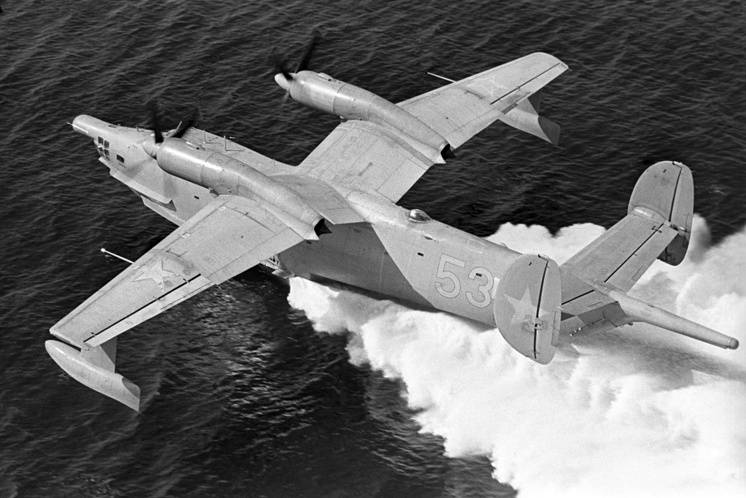
Be-12
Be-12
Anti-submarine amphibian (according to NATO codification: Mail).
In October, 1960, the plane made its first flight, and from 1963, began to come into service with naval aviation. Established in the Design Bureau named after G. M. Beriev.
On the amphibian aircraft, a set of target equipment is installed, allowing to conduct search and combat with enemy submarines.
The maximum speed is 550 km / h, the practical ceiling is 12100 meters, the maximum flight range is 4000 km.
As of 2015, the naval aviation of the Russian Navy consists of X-NUMX aircraft Be-7.
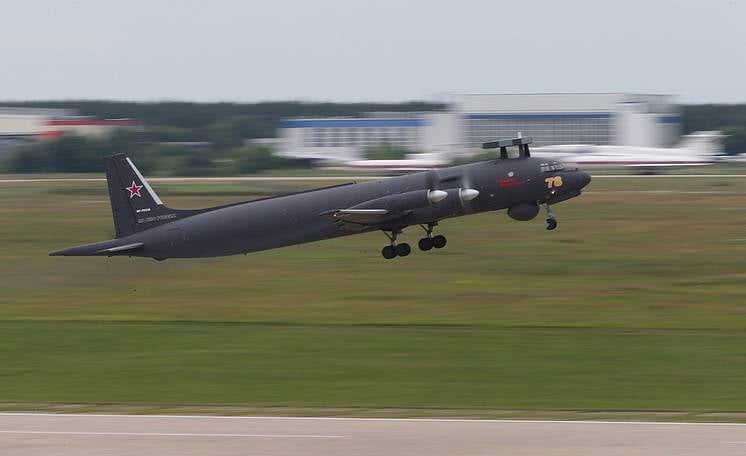
IL-38N
IL-38
Anti-submarine aircraft developed at the S. Ilyushin Design Bureau on the basis of passenger Il-18В (according to NATO codification: May).
The aircraft is designed to independently or jointly with anti-submarine ships to search for and destroy submarines, naval reconnaissance, search and rescue operations, and minefield fencing.
The first flight performed 27 September 1961 of the year. Total built 65 machines.
Crew - 7 man. The maximum speed is 650 km / h, the maximum flight range is 9500 km, the practical ceiling is 8000 meters.
Armed with anti-submarine torpedoes, anti-submarine bombs and sea mines.
In 2015, the Ilyushin Aviation Complex completed the contract for the repair and modernization of five IL-38 aircraft to the level of IL-38Н.
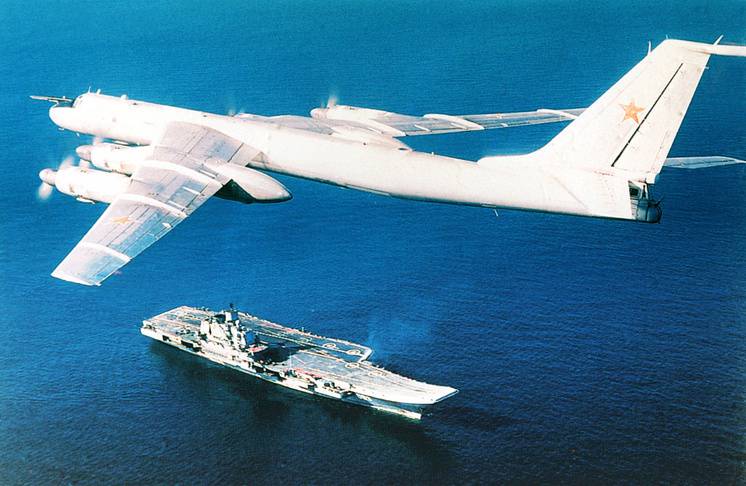
Tu-142M
Tu-142
Russian long-range anti-submarine aircraft (according to NATO codification: Bear-F).
It is used for long-distance ocean intelligence, visual or radio engineering, for duty in the search and rescue service system, and only then, for searching and tracking nuclear-powered submarines with ballistic missiles.
The first Tu-142 plant number 86 in Taganrog released in 1975 year. The last Tu-142М3 aircraft left the assembly hall in 1994 year.
In total, 1968-1994 produced about 100 Tu-142 copies of various modifications.
Crew - 9 man. The maximum speed is 855 km / h, the practical ceiling is 13500 meters.
Armed with explosive discharged sound sources, torpedoes, anti-submarine aircraft, anti-submarine and practical bombs, as well as naval mines.
For defense, a small-gun aft plant with two AM-23 or GSH-23L guns is used, as well as a set of radio countermeasures.
In service with the Russian Navy is one squadron in the Northern and Pacific Fleets.
In 2013, it became known that a new anti-submarine aircraft was being developed in Russia to replace the Tu-142М3.
Transport aircraft
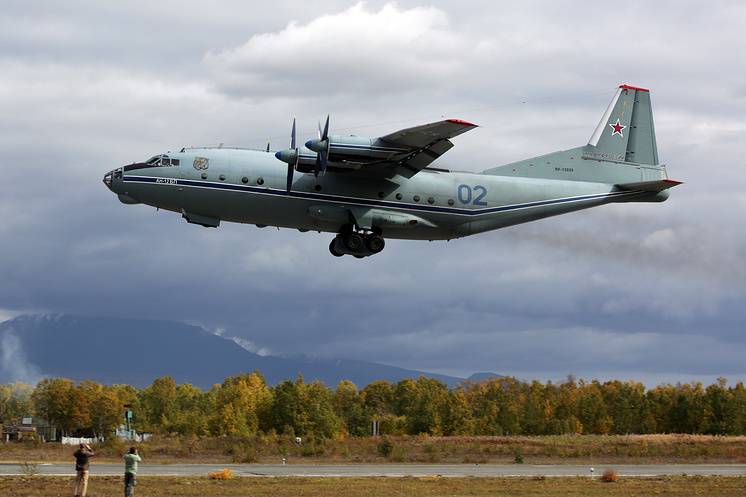
An-12
Military transport aircraft, developed in the Design Bureau. O. K. Antonova (on the codification of NATO: Cub - "Yunets").
The first An-12 took off in Irkutsk 16 December 1957 of the year. The aircraft has established itself as a very reliable machine, able to work in difficult climatic conditions and unpretentious to maintain.
The aircraft was actively used for military purposes, in emergency situations, for the transfer of military equipment and personnel, also for passenger and cargo transportation, search and rescue of space objects, manned spacecraft crews and aircraft in distress.
The artillery armament of the aircraft consists of the PV-23U cannon armament, which includes a DB-65U aft tower with two X-NUMX-mm AM-23 cannons, an electrical tower control system and an sighting and computing unit.
In addition, it can carry high-explosive fragmentation or incendiary aerial bombs of 70 kg on board up to 100.
The maximum flight speed is 660 km / h, the practical ceiling is up to 10 000 m, the flight range is up to 5530 km.
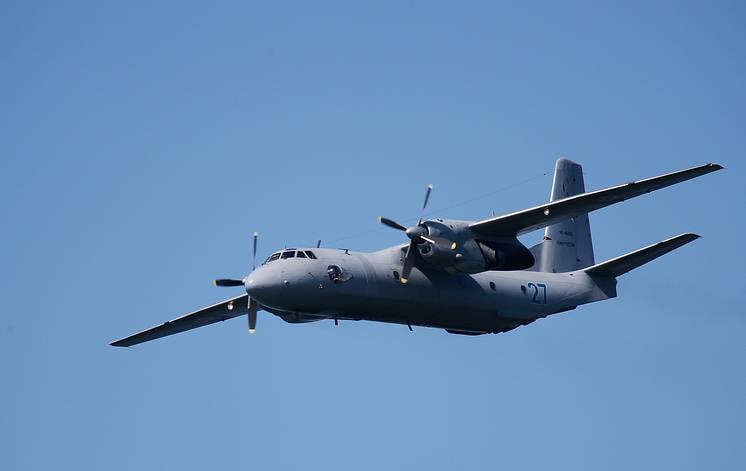
An-26
An-26
Military transport aircraft, developed in the Design Bureau. OK Antonov (according to the NATO codification: Curl - "Whirlwind", among the people - Humpback, Fantômas, Nastya, Nastya).
It is a modification of the original model An-24.
Aircraft crew - 6 man. Can carry on board 38 manpower or up to 30 paratroopers.
The maximum speed is 540 km / h, the flight range is up to 2660 km, the practical ceiling is 7300 m.
It can also be equipped with bombs caliber up to 500 kg.
Helicopters
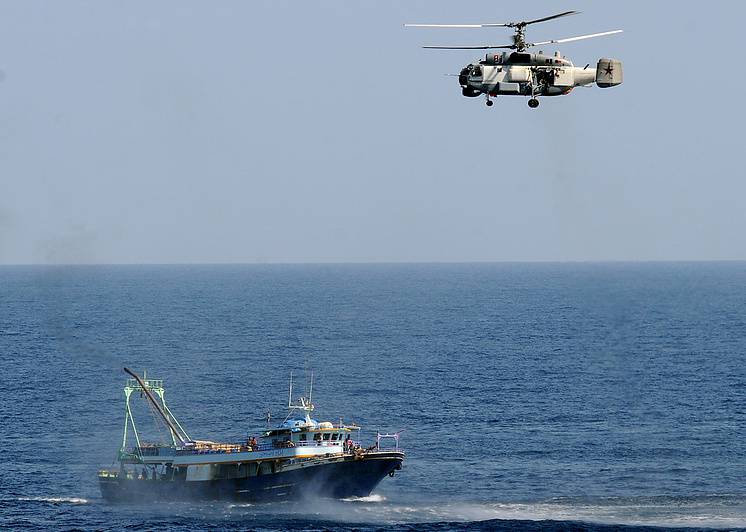
Ka-27
Ka-27
Ship anti-submarine helicopter (according to NATO codification: Helix - "Spiral").
Designed to solve the problems of the antisubmarine defense of the fleet based on ships of various classes, including aircraft carriers.
The helicopter is capable of detecting modern underwater and surface targets, transmitting information about them to the ship and coastal tracking points, as well as attacking them with the use of onboard weapons.
14 April 1981 was adopted.
To destroy submarines, anti-submarine torpedoes AT-1MB, APR-23 missiles and free-fall anti-submarine bombs of the PLN caliber 50 and 250 kg can be suspended from a helicopter.
The crew - 3 person, maximum speed - 270 km / h, practical flight range - up to 900 km, practical ceiling - 5000 m.
A promising naval aviation helicopter, which is being developed to replace the multipurpose Ka-27, received the code "Lamprey".
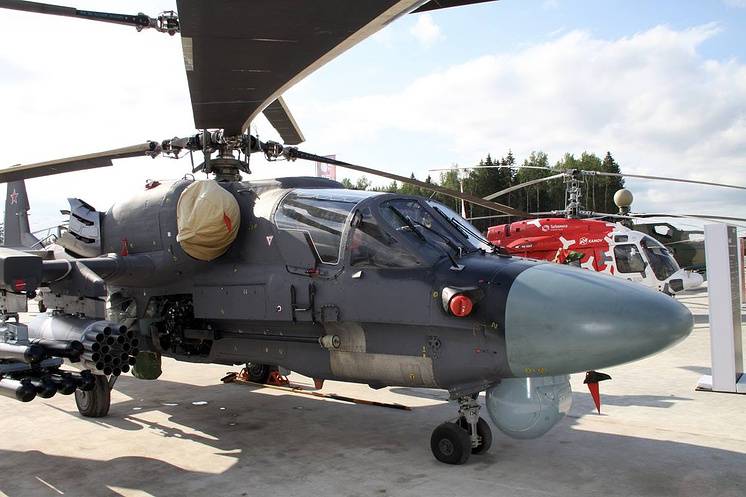
Ka-52K helicopter (ship)
Ka-52K
Ka-52 - multipurpose attack helicopter, is a modernization of the "Black Shark". Designed in Moscow by the design office of OJSC "Kamov".
Designed to destroy tanks, armored and unarmored military equipment, manpower and helicopters of the enemy in all weather conditions and at any time of the day.
It can provide fire support for the landing force, patrol and escort military convoys.
The first flight made 25 June 1997 of the year. Produced serially from 2008.
Ka-52 - a helicopter with a coaxial arrangement of bearing three-bladed propellers, two gas turbine engines, a straight wing, developed vertical and horizontal tail and retractable in-flight three-bearing landing gear.
Ka-52K - ship-based helicopter.
The crew consists of two people. Maximum speed - 300 km / h, practical range - 1 thousand 160 km, practical ceiling - 5,5 thousand meters.
Equipped with a 30 mm caliber cannon, guided and unguided rockets up to 2 thousand kg on 4 suspension units.
According to Deputy Minister of Defense Yuri Borisov, Ka-52, who demonstrated his high combat qualities during the Syrian campaign, has a serious modernization potential.
In 2015, Russia signed a contract with Egypt for the supply of Ka-46 Alligator helicopters 52. Can also put the ship Ka-52K "Katran", designed for helicopter carriers such as "Mistral".
Information